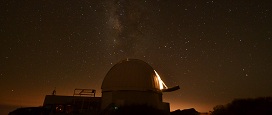2012 Press Releases
The world will go on

He says: “From a scientific point of view, we do have an understanding of how the world is likely to end (aside from issues concerning how humanity will take care of the planet in the future).
Astronomical observations of the solar system tell us that, in the past, the earth and other objects in the solar system have been bombarded by asteroids, comets, etc: on the earth, the larger of these impacts gave rise to climate change, tsunamis, and other catastrophic events. It is generally believed that dinosaurs became extinct 65 million years ago because of such an event, and we certainly cannot rule out an event of similar magnitude in the future - albeit millions of years from now.
Observations of the sun and similar stars also show that, as they age, their luminosity changes, and eventually they expand dramatically to become red giants. Even in the case of the sun, the small increase in its brightness expected over the next 1,000 million years is likely to have a devastating effect on the atmosphere of the earth. As the sun subsequently expands to become a red giant, it will engulf Mercury and Venus. As it does so, it will lose mass, which will have the effect of moving the earth further away from the sun. This is likely to be only a temporary reprieve, however, and it is thought that eventually even the earth itself will be subsumed by the bloated sun. Eventually, all that will remain of the sun, and its three inner-most planets, will be a white dwarf, an object about the size of the earth itself but 100,000 times more dense.
Even if the earth were to survive this, we face another dilemma in the (even) longer term. Recent observations of the cosmos show that the expansion of the universe is accelerating. Hence, the distance between galaxies will continue to expand forever: the stars they contain will eventually use all of their nuclear fuel, and become white dwarfs, neutron stars or black holes. The light we see in the night sky from our astronomical neighbours will eventually be extinguished, and the earth (if it has somehow survived to this point) will face a cold and dark eternity.”
However, Callanan points out that the above is likely to occur many tens of thousands of millions of years’ time: we still have more than enough time to worry about last minute Christmas shopping on December 22, 2012."
View the film where Professor Paul Callanan explains how scientists believe the world will end. The film is the Editor's Choice in The Irish Times today http://www.irishtimes.com/newspaper/world/2012/1221/1224328081014.html
